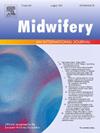Perceptions of care providers on the implementation of an antenatal psychosocial clinical decision support system: the Born in Belgium Professionals platform
IF 2.5
3区 医学
Q1 NURSING
引用次数: 0
Abstract
Background
Clinical decision support systems (CDSS) can enhance care processes and clinical outcomes. Adoption depends not only on perceived usefulness but also on contextual human, organisational, and technical factors. Understanding care providers’ perception and how these factors influence adoption is essential for implementing systems that can be embedded in routine perinatal practice.
Aim
To examine the real-world adoption (or uptake) of the Born in Belgium Professionals antenatal psychosocial decision-support platform, describing how and why care providers use it and identifying facilitators and barriers to sustained implementation.
Methods
A cross-sectional survey of all active users (March–July 2024) captured frequency of use, motivations, and perceptions. Frequent versus non-frequent users were compared with chi-square and Mann–Whitney tests (p < .05).
Findings
Of 313 users, 127 responded; most were midwives working in large organisations. About 46% were frequent users. Motivators were the psychosocial questionnaire, continuity of care and preventive benefit. Frequent users more often attended training (64.4% vs 30.9%; p < 0.001), perceived greater patient benefit (median 4.5 vs 4.0; p = .046) and rated the platform’s integration in electronic health record (EHR) higher (median 5.5 vs 5.0; p = .002). Non-frequent users cited time pressure and interoperability issues.
Discussion
Positive perceptions of benefits, adequate training, and seamless workflow integration promote sustained use. Organisational support and robust interoperability further facilitate uptake, whereas time pressures and suboptimal EHR embedding hinder regular use.
Conclusion
Implementation strategies that emphasise training, interoperability, and alignment with existing workflows are essential to optimise adoption of antenatal psychosocial decision-support systems.
护理提供者对产前社会心理临床决策支持系统的实施的看法:出生在比利时的专业人士平台
临床决策支持系统(CDSS)可以提高护理过程和临床结果。采用不仅取决于感知到的有用性,还取决于环境中人、组织和技术因素。了解护理提供者的看法以及这些因素如何影响收养对于实施可嵌入常规围产期实践的系统至关重要。目的研究现实世界中出生在比利时的专业人士产前心理社会决策支持平台的采用(或吸收),描述护理提供者如何以及为什么使用它,并确定持续实施的促进因素和障碍。方法对所有活跃用户(2024年3月至7月)进行横断面调查,获取使用频率、动机和看法。使用卡方检验和Mann-Whitney检验比较频繁使用者和非频繁使用者的差异(p < 0.05)。在313个用户中,127个回复;大多数是在大型机构工作的助产士。约46%的人是频繁用户。动机是心理社会问卷、护理的连续性和预防效益。频繁用户更频繁地参加培训(64.4% vs 30.9%; p < 0.001),认为患者获益更大(中位数为4.5 vs 4.0; p = 0.046),并对平台在电子健康记录(EHR)中的集成评分更高(中位数为5.5 vs 5.0; p = 0.002)。不经常使用的用户提到了时间压力和互操作性问题。积极的利益认知、充分的培训和无缝的工作流集成促进了持续的使用。组织支持和强大的互操作性进一步促进了采用,而时间压力和次优的EHR嵌入阻碍了常规使用。结论强调培训、互操作性和与现有工作流程保持一致的实施策略对于优化产前社会心理决策支持系统的采用至关重要。
本文章由计算机程序翻译,如有差异,请以英文原文为准。
求助全文
约1分钟内获得全文
求助全文
来源期刊

Midwifery
医学-护理
CiteScore
4.50
自引率
7.40%
发文量
221
审稿时长
13.4 weeks
期刊介绍:
Midwifery publishes the latest peer reviewed international research to inform the safety, quality, outcomes and experiences of pregnancy, birth and maternity care for childbearing women, their babies and families. The journal’s publications support midwives and maternity care providers to explore and develop their knowledge, skills and attitudes informed by best available evidence.
Midwifery provides an international, interdisciplinary forum for the publication, dissemination and discussion of advances in evidence, controversies and current research, and promotes continuing education through publication of systematic and other scholarly reviews and updates. Midwifery articles cover the cultural, clinical, psycho-social, sociological, epidemiological, education, managerial, workforce, organizational and technological areas of practice in preconception, maternal and infant care.
The journal welcomes the highest quality scholarly research that employs rigorous methodology. Midwifery is a leading international journal in midwifery and maternal health with a current impact factor of 1.861 (© Thomson Reuters Journal Citation Reports 2016) and employs a double-blind peer review process.
 求助内容:
求助内容: 应助结果提醒方式:
应助结果提醒方式:


